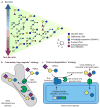A microbial perspective of human developmental biology
- PMID: 27383979
- PMCID: PMC5358965
- DOI: 10.1038/nature18845
A microbial perspective of human developmental biology
Abstract
When most people think of human development, they tend to consider only human cells and organs. Yet there is another facet that involves human-associated microbial communities. A microbial perspective of human development provides opportunities to refine our definitions of healthy prenatal and postnatal growth and to develop innovative strategies for disease prevention and treatment. Given the dramatic changes in lifestyles and disease patterns that are occurring with globalization, we issue a call for the establishment of 'human microbial observatories' designed to examine microbial community development in birth cohorts representing populations with diverse anthropological characteristics, including those undergoing rapid change.
Conflict of interest statement
Figures


References
-
- Sender R, Fuchs S, Milo R. Are we really vastly outnumbered? Revisiting the ratio of bacterial to host cells in humans. Cell. 2016;164:337–340. - PubMed
-
- Gordon JI, Knowlton N, Relman DA, Rohwer F, Youle M. Superorganisms and Holobionts. Microbe. 2013;8:152–153.
-
- Levison M, Corman L, Carrington E, Kaye D. Quantitative microflora of the vagina. Am J Obstet Gynecol. 1977;127:80–85. - PubMed
Publication types
MeSH terms
Grants and funding
LinkOut - more resources
Full Text Sources
Other Literature Sources
Miscellaneous

